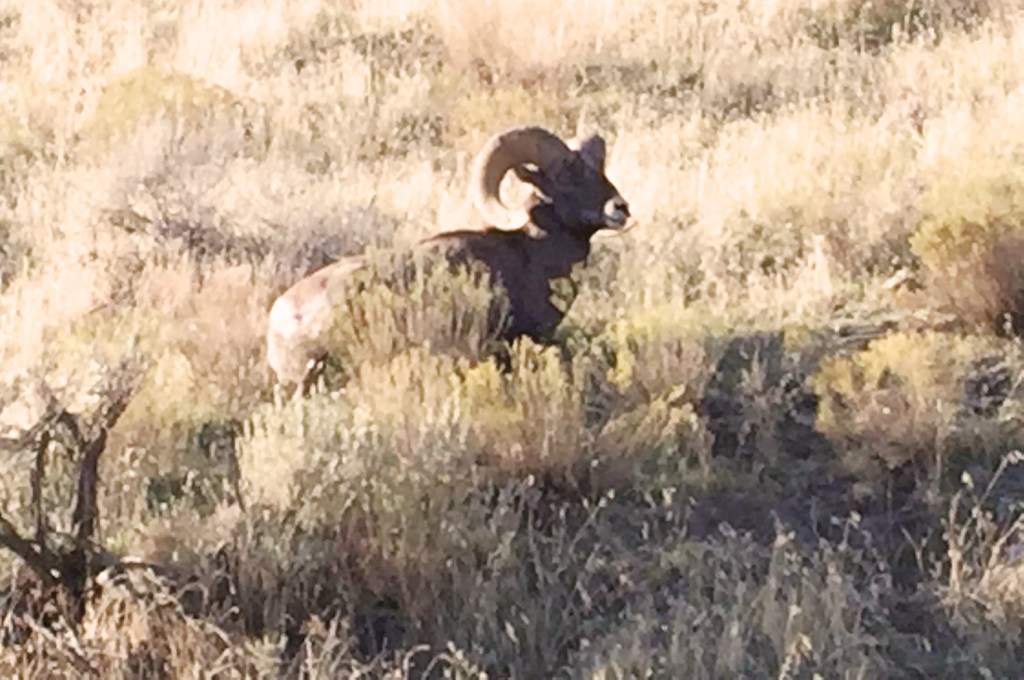Gorging on the green
Published 2:50 pm Friday, May 26, 2017

- Dave Britton photoA bighorn sheep ram grazes near the Snake River in eastern Baker County earlier this month. Beneath the dried brown grass is a flush of new green grass that’s an important food source for sheep and other big game animals, as well as upland game birds, as they prepare for winter’s deprivations.
The green grass that has kept a bright bit of summer in your yard brings much more than aesthetic value to Northeastern Oregon’s big game animals and upland game birds.
Trending
For them it might even mean the difference between life and death.
The combination of a damp October and an unseasonably balmy first half of November has prompted a lush crop of new grass to sprout in the region’s drought-desiccated rangelands.
That grass is an ideal food for deer, elk, bighorn sheep and chukar partridges as they prepare for the deprivations of winter, said Justin Primus, a wildlife biologist at the Oregon Department of Fish and Wildlife’s (ODFW) Baker City office.
Trending
The ample supply of nutritious forage helps animals amass a layer of fat that can sustain them during the frigid days ahead, Primus said.
“The rains that we got early, and the warm spell in November, helped us a lot,” he said. “The old dried and cured grass doesn’t have the forage value that the new green grass does.”
The new grass is also more palatable for animals, Primus said.
Deer are probably the biggest beneficiaries, he said, and in particular this year’s crop of fawns.
With their relatively small body mass, fawns are vulnerable to prolonged winter cold snaps, when animals burn plenty of calories just to maintain their body heat.
“Every little bit they can get now, especially with the drought we had this summer and the poor forage conditions, is helpful,” Primus said.
Elk are generally hardier than deer, although they, along with other big game animals, also benefit from the abundant forage so near to winter.
The drought hasn’t been as severe in Wallowa County as in Baker and Union counties.
But the greenup in the former county is still welcome, said Pat Matthews, district wildlife biologist at ODFW’s Enterprise office.
“Certainly it’s helping big game at this time, particularly deer that have already started using the lower elevations,” Matthews said.
The warm temperatures that prevailed until earlier this week also were a boon for big game, he said, by melting most of the snow that fell in early October.
“It’s always beneficial when you have bare ground this late in the fall,” Matthews said.
ODFW biologists started their annual fall aerial census of deer this week, and animals appear to be in good shape as winter looms, he said.
The glut of green forage isn’t the only advantage big game animals have had during this unusual autumn, Primus said.
The warm start to November — the temperature was above normal every day from Nov. 1-15 at the Baker City Airport, for instance — also meant animals could turn much of that forage into fat rather than expending it to stay warm, he said.
Moreover, animals didn’t have to spend as much time eating, which allowed them to take advantage of cover during the day, making them less vulnerable to predators.
Typically by November animals have to feed much of the day to sustain their fat reserves, Primus said. And because the best forage tends to be in open areas, animals have to expose themselves to predators such as coyotes and cougars.
Temperatures were so warm on some days in early November that it’s likely deer and other animals took to the shelter of the forest not only for protection from predators, but to cool off from the unusually warm sun, Primus said.
That’s quite a contrast to the previous two Novembers, when temperatures were below average in Northeastern Oregon.
In 2014, for example, the temperature plunged to 7 below zero at the Baker City Airport on Nov. 15.
Although an extremely harsh winter could still wreak havoc on deer herds, Primus said the animals will be better able to withstand polar conditions than they would have been without the greenup.
“There’s reason to be optimistic that the deer counts next spring will be better than we’ve had the past few years, especially if the winter is not harsh,” he said. “It would be nice to stay on an upward trend with deer.”
Upland game birds
Chukars will benefit most from the greenup because they usually live along ridges and in canyons where green forage can be scarce, especially in the autumn of a drought year, Primus said.
Other species, such as California quail, forest grouse and pheasants, tend to congregate along streams where green grass usually is available even during droughts.









